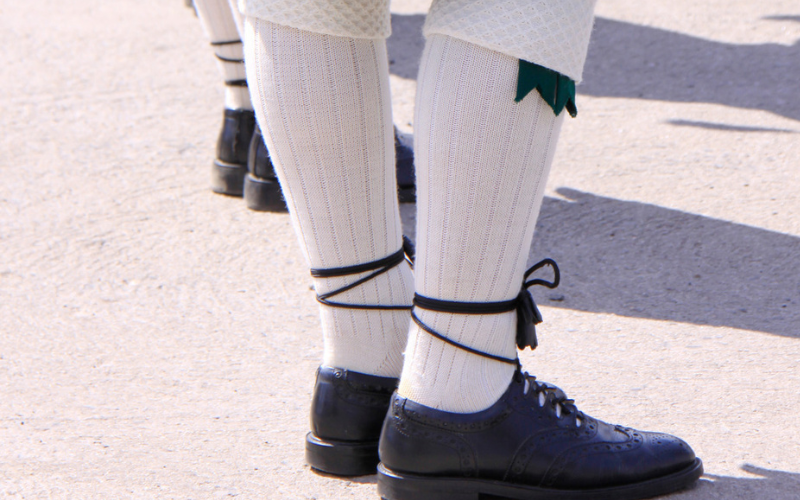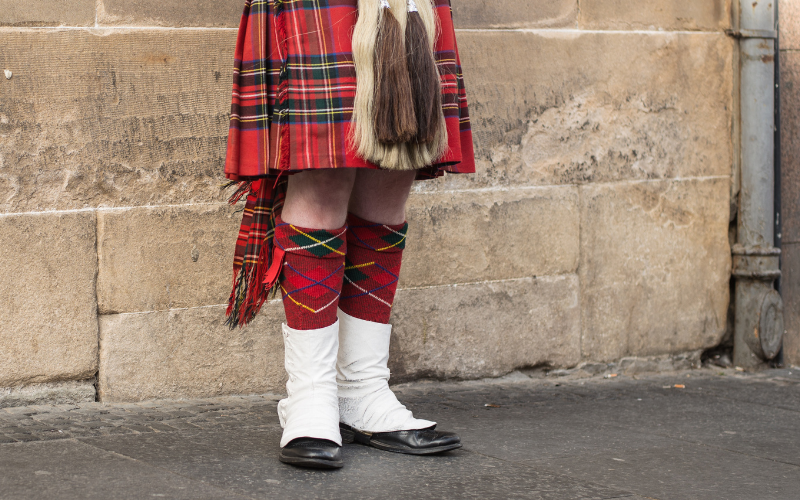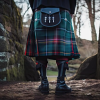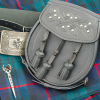When it comes to donning a kilt, the right pair of boots can make all the difference in stepping out with confidence and style. From traditional Highland gatherings to contemporary urban settings, choosing the perfect boots for your kilted ensemble is a nuanced art. In this comprehensive guide, we’ll explore the diverse world of kilt-friendly footwear, uncovering the best options to elevate your Scottish attire and leave a lasting impression.
The Intersection of Tradition and Style:
Kilts, rooted in Scottish tradition, have evolved into a versatile garment that effortlessly blends tradition with modern fashion. The same can be said for the boots that accompany them. Whether you’re attending a formal event or simply strolling through city streets, the right boots can enhance your overall look while providing comfort and functionality.
Traditional Ghillie Brogues:
For those embracing the classic Scottish look, Ghillie brogues are a timeless choice. These leather shoes, characterized by their distinctive lacing system, add an air of sophistication to any kilt ensemble. Typically worn with kilt hose and flashes, Ghillie brogues are a staple at formal occasions such as weddings, ceilidhs, and traditional gatherings. Opt for a polished black or brown pair to seamlessly integrate with your kilt’s color palette.
Practicality Meets Style with Combat Boots:
Combat boots seamlessly blend functionality with a rugged and edgy style, making them a versatile choice for individuals seeking a distinctive look to pair with their kilts. These boots, originally designed for military use, have transcended their utilitarian origins to become a fashion statement that effortlessly complements various outfits, including traditional Scottish kilts.

Key Features:
1. Sturdy Construction:
Combat boots are renowned for their robust and durable construction. Typically made from high-quality leather or synthetic materials, these boots are designed to withstand challenging terrains and provide excellent ankle support. The sturdy build makes them ideal for both urban environments and outdoor adventures.
2. Lacing and Fastening:
The distinctive lacing system of combat boots not only adds to their aesthetic appeal but also contributes to a secure and adjustable fit. The laces can be tightened for extra support or loosened for a more relaxed feel. Some combat boots also feature side zippers for quick and easy wear.
3. Versatile Style:
One of the standout features of combat boots is their ability to effortlessly blend with various fashion styles. Whether you’re aiming for a punk-inspired look, a casual streetwear vibe, or a rugged outdoorsy aesthetic, combat boots can be styled to suit different occasions and personal tastes.
4. Chunky Soles:
Combat boots often feature chunky, slip-resistant soles. These not only provide traction on different surfaces but also add to the boots’ overall rugged appearance. The substantial soles contribute to the durability and practicality of combat boots, making them suitable for a wide range of activities.
5. Color Variety:
Combat boots are available in a range of colors, with classic choices being black and brown. The color versatility allows wearers to match their boots with the color palette of their kilts, making it easier to create a cohesive and stylish ensemble. Some individuals also opt for distressed or weathered finishes for a more worn-in and authentic look.
Styling Tips:
1. Casual Kilting:
Combat boots effortlessly complement casual kilting. Pair them with a contemporary or utility-style kilt for a laid-back, edgy appearance. Tuck in a graphic tee or opt for a casual shirt to complete the look. The juxtaposition of the traditional kilt with the modernity of combat boots creates a unique and eye-catching outfit.
2. Layering for Edge:
Experiment with layering to enhance the edgy appeal of combat boots. Combine them with skinny jeans or cargo pants and a leather jacket for an urban, rebellious vibe. The combination of combat boots and layered clothing adds depth and personality to your overall style.
3. Accessories:
Complement your combat boots and kilt ensemble with accessories like a studded belt or metal jewelry to enhance the rugged aesthetic. Consider incorporating elements of punk or military-inspired accessories to elevate the overall style and make a bold fashion statement.
The Classic Appeal of Chelsea Boots:
For those who appreciate a blend of classic and contemporary, Chelsea boots provide a versatile option. These ankle-length boots, often made from leather or suede, offer a sleek and polished appearance. Chelsea boots effortlessly transition from day to night, making them suitable for both formal events and casual outings. Pair them with a kilt for a sophisticated yet understated look.

Embracing the Outdoors with Hiking Boots:
If your kilted adventures take you into the great outdoors, consider investing in a pair of sturdy hiking boots. Designed for comfort and durability, hiking boots provide ample support for long walks or treks. Opt for waterproof options to ensure you’re prepared for unpredictable weather. The rugged aesthetic of hiking boots can add a touch of adventure to your kilt ensemble, making them a practical and stylish choice.
Modern Elegance with Desert Boots:
For a contemporary twist on traditional kilt footwear, consider desert boots. These ankle-length boots, often made from suede, exude modern elegance while maintaining a casual vibe. Desert boots come in various colors, allowing you to experiment with different shades to complement your kilt. Their lightweight and comfortable design makes them suitable for both formal and casual occasions.
Choosing the Right Boots for Your Kilt:
While the options are diverse, selecting the perfect boots for your kilt involves considering factors such as the occasion, personal style, and comfort. Here are some additional tips to help you make an informed decision:
- Color Coordination: Ensure that the color of your boots complements the hues of your kilt. Traditional black, brown, and neutral tones are versatile choices that can seamlessly integrate with various kilt designs.
- Material Matters: Pay attention to the material of the boots. Leather boots exude a classic and polished look, while suede or fabric options offer a more casual and contemporary feel. Choose based on the formality of the event and your style.
- Consider the Setting: The setting plays a crucial role in determining the appropriate boots. Ghillie brogues may be perfect for formal occasions, while combat or hiking boots suit a more casual or outdoor setting. Chelsea boots provide a versatile option that can transition between different environments.
- Comfort is Key: Regardless of style, prioritize comfort. You’ll likely be on your feet for extended periods, so opt for boots with proper arch support and a comfortable fit. Breaking in new boots before a significant event ensures you can step out with ease.
Conclusion:
Stepping out in style with kilt-friendly footwear is an art that combines tradition, personal style, and practicality. Whether you choose the classic Ghillie brogues, the rugged appeal of combat boots, the versatility of Chelsea boots, the outdoorsy charm of hiking boots, or the modern elegance of desert boots, the key is to strike a balance that enhances your kilted ensemble.
As you explore the diverse world of boots for kilts, remember that each pair tells its own unique story. From formal gatherings to casual outings, the right boots can elevate your confidence and leave a lasting impression. So, embrace the fusion of tradition and style, and step into the world with your best foot forward in a pair of boots that perfectly complements your kilted attire.
Combat boots offer a perfect synergy of practicality and style, making them an excellent choice for those looking to add a touch of edginess to their kilted outfits. Whether you’re attending a casual gathering, exploring the outdoors, or simply expressing your unique fashion sense, combat boots provide a versatile and fashionable footwear option that confidently bridges the gap between tradition and modernity.
FAQs
1. What type of boots are best suited for wearing with a kilt?
- The ideal boots for a kilt depend on the occasion and personal style. Traditional options like Ghillie brogues offer a classic look for formal events, while combat boots provide a more rugged aesthetic. Chelsea boots seamlessly blend classic and contemporary styles, while hiking boots and desert boots offer practical choices for outdoor or casual settings.
2. Can I wear any color of boots with a kilt?
- While there’s flexibility in choosing boot colors, it’s advisable to coordinate with the colors of your kilt. Traditional choices like black and brown are versatile and can complement various kilt designs. Neutral tones also work well. Consider the formality of the event and your style when selecting the color of your boots.
3. Are there specific boots for different types of kilts?
- The type of kilt you’re wearing can influence your choice of boots. For example, Ghillie brogues are well-suited for traditional Scottish kilts, while combat boots or desert boots may pair better with modern or casual kilts. Consider the style, material, and formality of both the kilt and the event to make an informed decision.
4. How do I ensure my boots are comfortable for extended wear?
- Comfort is crucial when choosing boots for a kilted ensemble. To ensure comfort during extended wear, select boots with proper arch support and a comfortable fit. It’s advisable to break in new boots before a significant event by wearing them for short periods. This allows the boots to adjust to the shape of your feet and reduces the likelihood of discomfort.
5. Can I wear hiking boots with a kilt to a formal event?
- While hiking boots are generally more casual, there’s room for flexibility based on the formality of the event. For formal occasions, it’s recommended to opt for more traditional choices like Ghillie brogues or polished Chelsea boots. However, if the event has a casual or outdoor theme, hiking boots can be a stylish and practical choice, adding a touch of adventure to your kilted ensemble.




Leave a reply